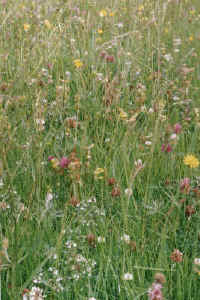| If purchasing this
seed mix, print this page and keep it as your reference.
Native Origin Irish Wildflower Seed Mixture: Range: Meadow Mixtures (Code MM) Supplied without grass, Grass seed can be added Product Name: MM12 Wild Flora for Raw Impoverished Sub Soil Product Code: MM12 Description:
Wild Flora for Raw Impoverished Sub Soil is a Basic mixture, which can grow with the poorest of site conditions and can be sown with grasses to hold the clay from eroding, esp' on steep banks.
This mixture will grow well on un-worked wet soils acidic gleys, clays and
daub basic soils. Species
List: This mixtures contains 1% native grass seed harvested with The Yellow Rattle, 1% grass is so little you will hardly notice it, the grass acts as a host for Yellow Rattle.
Because all the species in this mixture are suited to harsh sites they will out grow the grass and can be left un-cut until the end of summer. You will have to make a judgment as to when to cut, do not cut so late that it starts to 'lodge' or fall over.
The species in this mixture are found in many Irish fields
on Wet acidic 'Daub', 'Gley' or very wet, heavy sticky soil that is water impervious
and the pH is acid to neutral. (Classified as Podzol). MM12 will grow on
poor soil with little fertility and tolerates wind swept areas.
This strong coloured, bright flowery mixture makes an ideal choice for
many new houses throughout the midlands of Ireland, as MM12 will grow on
compacted, denuded and poor soils typical throughout much of the midlands
from East Mayo to Louth, from Laois to Roscommon, Cavan and Fermanagh.
After a few years, this mixture will develop a skim of peaty topsoil, and
more species may be added. Redshank is included, it is an annual weed, added to provide pink/red tones in the first year as the red Poppy tends not do well on acid clay soil but are included Do not confuse 'Meadow Buttercup' supplied in this mixture, with the invasive 'Creeping Buttercup', which is not included, but may be present on such soil. To control Creeping Buttercup, cut the meadow just before the Creeping Buttercup flowers, if the problem gets worse over-sow the meadow with grasses to control infestations. Rush is also a weed typical of such soils, the site should be clean of rush before sowing and as rush emerges from seeds present in your soil treat it. See elsewhere on this site for details. Search Rush and Common Rush.
Mixture Specifications: This photograph is one day in the life of an ever changing meadow. Product Warning: DBN recommends that this mixture is not for human or animal consumption.
Sowing Specification:
Sowing Conditions:
Sow and roll in, leave on the top of the soil, If doing so it can be mixed with grass
Seed Sowing Rates:
Grass seed or nurse crop requirement: Nurse
Crop: No nurse crop is required. If sown without
grass seed,
this mixture:
Will not require a nurse crop. Performance: The
annuals supplied in this mixture will
flower profusely, provided they are sown before June. This mixture requires one cut when finished flowering. When
should this meadow be established and require one cut? A wildflower meadow should last many years, provided the wildflower species were correctly established, weeds were controlled and the meadow was cut and the cut material removed and occasional 'Gaps' are created. If not contact DBN.
Persistence if unmanaged: Low Disposal of cut materials: Always remove the cuttings, wildflower meadow hay should be removed as soon as possible and not be heaped on site as it will grow mouldy (a health risk). Meadow cuttings can be spread as compost in sheet mulches around trees and shrubs or composted. Management: Control grasses and weeds until well established. Accept any normal non-invasive weeds as they provide cover, once the sward is established, digging, spot spraying or weed wiping can be used to eliminate problem species. Control weeds, especially Creeping Buttercup and White Clover, if present cut this meadow in May in year two. The third year is the critical year to maintain this meadow as scutch grass, creeping thistle, nettle and dock will try to dominate as the growing conditions are ideal for such unwanted species. Most species in this mixture are 'Browse' resistant.
A
General Description of Meadow Range:
Your purchase:
Contributes to DBN's work of creating crops
of Conservation Grade - Native Origin Wildflora. You help us to inform
and pay land-owners to manage native species and to assist DBN in
handing on our heritage for another generation. |
|
